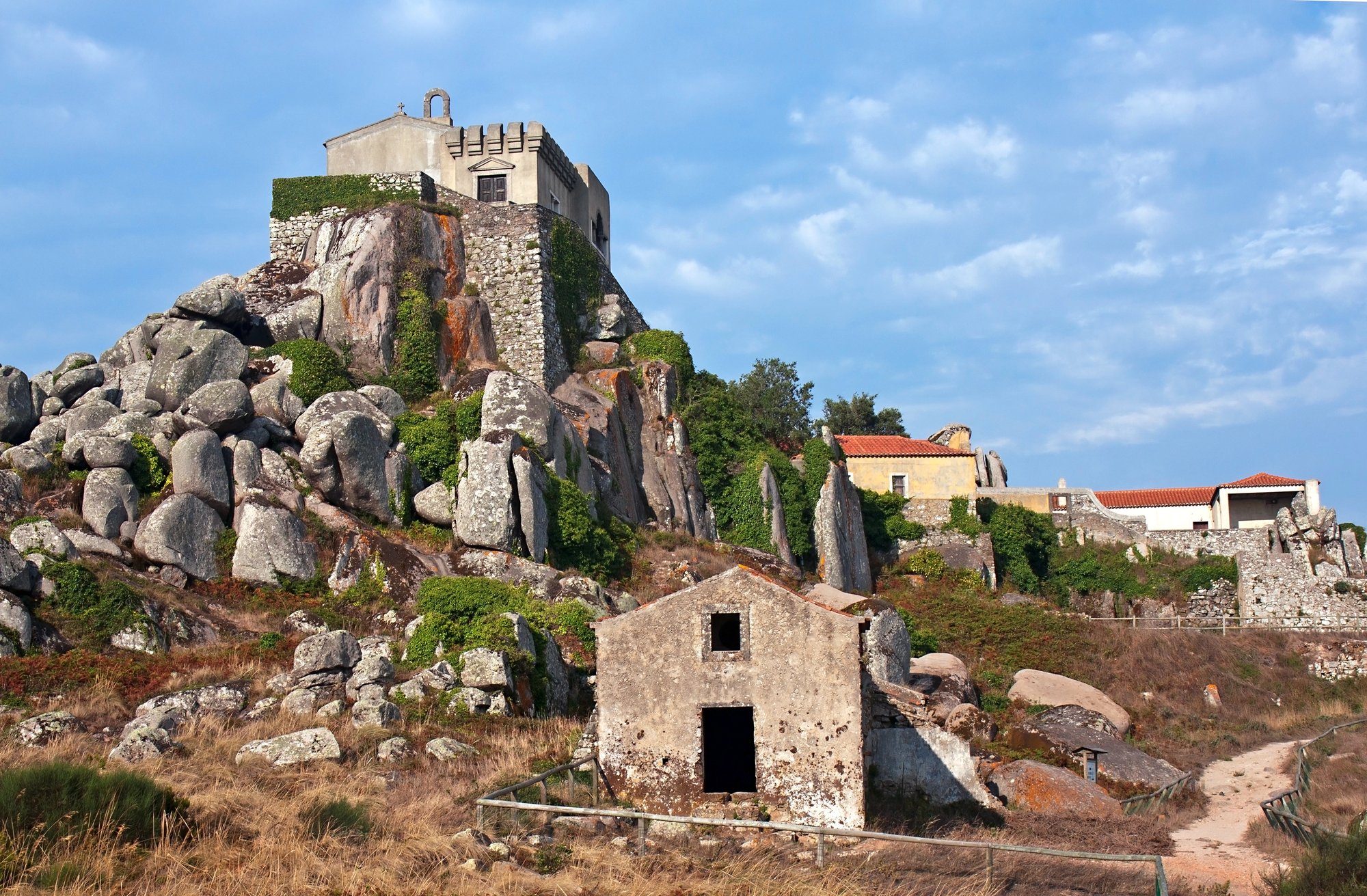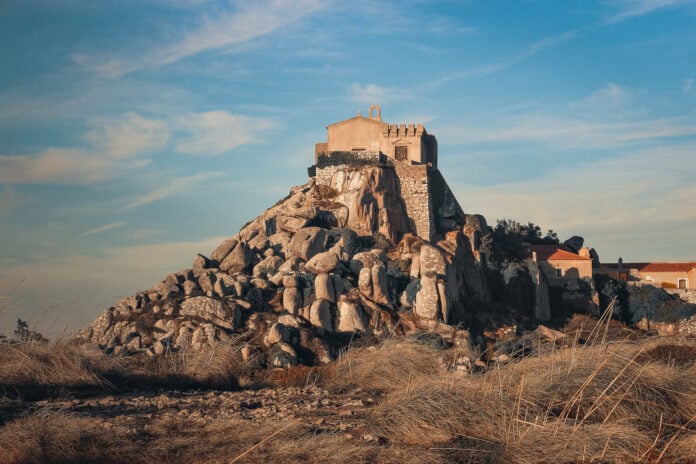One of Portugal’s most magical sanctuaries rests at the top of a rocky outcrop in the Sintra mountains looking out over breathtaking 360-degree views of the Atlantic Ocean.
Located just a short drive from Sintra’s more famous palaces, the Sanctuary of Peninha (Santuário da Peninha) stands at an impressive altitude of 448 meters above sea level. This remarkable complex includes a beautiful baroque chapel, the ruins of an ancient hermitage to Saint Saturnin, and a small palace built in 1918, all set against the dramatic backdrop of Sintra’s mystical landscape. Despite its historical and cultural significance, Peninha remains one of the region’s lesser-known treasures, a peaceful alternative to Sintra’s more crowded attractions.
The Legend of Peninha
Peninha was born out of legend. During the reign of King João III in the 16th century, a deaf and mute shepherd who grazed his sheep in the area noticed one of his animals had gone missing. Looking around, he spotted a lady approaching with his lost sheep. Though unable to speak, the shepherd expressed his gratitude as best he could. The lady asked him for some bread, but the shepherd explained that he had none because he was very poor.
The mysterious lady then instructed him that, upon arriving home, he should call for his mother and ask for bread.
When the shepherd returned home, a miracle occurred—the shepherd called out to his mother and found his voice restored. After explaining the encounter, they searched their home and discovered their chest mysteriously filled with enough bread to feed the entire village.
In gratitude, the villagers climbed the hill to where the shepherd had met the lady and erected a statue of Our Lady at the exact spot. This location became a sacred place of worship, and it is believed to be the site where the Virgin Mary had appeared.
In the 17th century, a chapel dedicated to Our Lady of Peninha was constructed with the support of King Pedro II.
Architecture
While the current sanctuary dates primarily from the late 17th and early 18th centuries, the site’s sacred history stretches back much further. Archaeological excavations conducted by the Sintra-Cascais Natural Park uncovered a necropolis with rock-cut graves dating to the end of the 12th century, along with a cistern carved into the rock.
Historical records indicate that as early as the 12th century, a hermitage dedicated to Saint Saturnin stood here, built by Pêro Pais, a standard-bearer to Portugal’s first king, Afonso Henriques. This early structure was followed by the Hermitage of San Saturnino in the mid-16th century.
The current chapel’s interior is considered an excellent example of Portuguese baroque architecture. Its walls are entirely covered with tiled panels depicting scenes from the Virgin Mary’s life, alongside representations of the Pentecost and Jesus’s childhood. The artistic work is complemented by exquisite marble inlays.

A Sacred Site and a Palace
In 1892, Peninha was purchased by the first Count of Almedina. The final addition to the sanctuary complex was a romanticist palace built by Portuguese entomologist and businessman António Augusto Carvalho Monteiro, who also created the famous Quinta da Regaleira in Sintra.
Carvalho Monteiro envisioned a smaller version of Sintra’s Pena Palace—a play on words, as in Portuguese, “pena” means “rock outcrop,” while “peninha” refers to a smaller outcrop. Unfortunately, he died before completing his ambitious project, and the palace remained unfinished.
After his death, the property changed hands several times. Dr. José Maria Ferreira Rangel de Sampaio acquired it and commissioned an architect to complete the palace, but the work was never carried out. Upon Dr. Sampaio’s death, he bequeathed the palace to the University of Coimbra. In 1991, the entire 62-hectare complex was purchased by the Portuguese government and placed under the management of the Portuguese Institute for Nature Conservation and Forests.
Renewal and Conservation
In June 2017, an important agreement was reached for Sintra Parks to carry out the rehabilitation of the Sanctuary of Peninha. The management plan focuses on promoting nature conservation and education, while improving the security and maintenance of the complex.
The plan also aims to better connect Peninha with other nearby points of interest in the Sintra mountains, such as Anta de Adrenunes, the Convent of the Capuchos, and Cabo da Roca, Europe’s westernmost point.
Given its high altitude and difficult access, visiting the sanctuary became a form of penance for the faithful. It was also a popular pilgrimage site for sailors’ families, who would pray for the safe return of their loved ones at sea. From Peninha’s summit, visibility extends up to 50 kilometers out to sea, allowing families to watch for returning ships on the horizon.

How to Get There
By Car: From Sintra, take the N247 road toward Colares and follow signs for Azóia/Cabo da Roca. Near Azóia, look for signs pointing to “Santuário da Peninha.” The final approach involves a narrow, winding road up the mountain.
By Public Transportation: Take the 403 bus from Sintra to Azóia, then hike approximately 3km uphill to reach the sanctuary. Comfortable walking shoes are recommended.
Parking: Limited parking is available near the sanctuary. Arriving early is advised, especially during summer months.
Opening Hours
The sanctuary grounds are open daily from sunrise to sunset and entrance is free. Currently, the interiors of the chapel and palace are not open to the public, but the Sanctuary of Peninha is a fantastic stop along the circular walk through Sintra National Park. Walk along the terraces and beautiful fields near the sanctuary and don’t be surprised if you see a few wild horses along the way.


